Choosing the Perfect Rug for Muddy Dog Paws
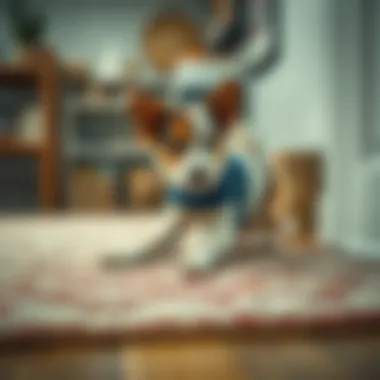
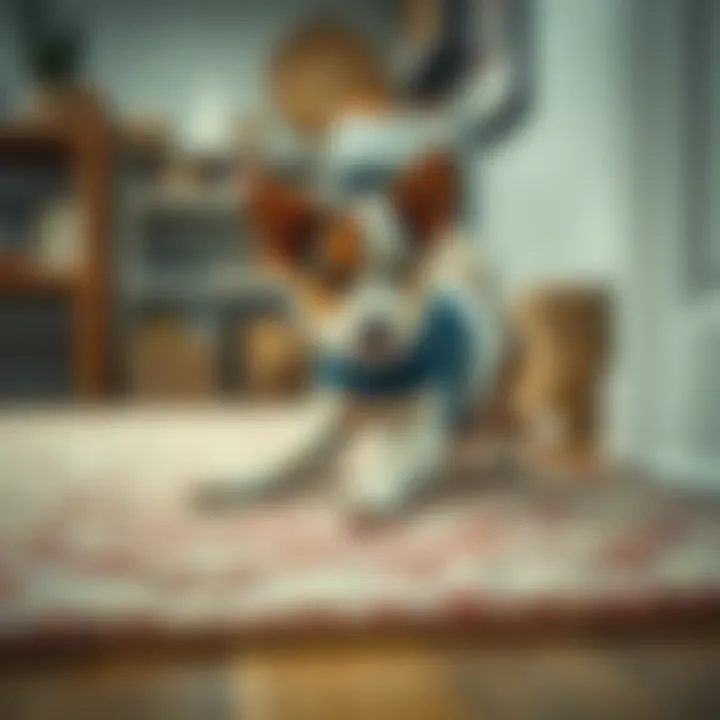
Intro
Choosing the right rug when you have a dog can feel a bit like navigating a minefield. One moment, you're hosting a cozy gathering with friends, and the next, your furry companion bounds through the mud, leaving a trail of dirt across your freshly cleaned floors. For dog owners, finding a rug that not only looks great but can withstand the wear and tear of muddy paws is essential.
Material Matters
When it comes to selecting a rug, the material is often the first consideration. Some materials hold up better against muddy paws than others, making it crucial to understand how each one performs under pressure. Here are a few solid options:
- Nylon: This is a sturdy fabric that’s resistant to stains and easy to clean. If your dog has a penchant for mud, nylon might be the best ally.
- Polyester: Another durable choice, polyester can be both soft and resilient. It’s less expensive compared to other options and still holds up well under daily wear.
- Outdoor Rugs: Made from synthetic materials, outdoor rugs can easily handle the mess. They often have a textured surface that makes cleaning a breeze.
"Selecting the right material can mean the difference between a rug that looks new for years and one that quickly shows signs of wear and tear."
Design Considerations
Aesthetics play a significant role in your decision. You want a rug that fits seamlessly into your living area while also being practical. Here are vital points to ponder while making your choice:
- Color: Darker colors can help mask stains and muddy paw prints better than lighter shades. Patterns can also help in hiding imperfections.
- Thickness: A thicker rug may feel luxurious underfoot but can be trickier to clean. Conversely, a thinner rug might not retain as much dirt but is easier to maintain.
- Texture: Some dogs may prefer textured rugs to smooth ones. As they roam around, a textured surface can also act as a natural paw cleaner.
Maintenance Practices
Even the most durable rug needs care. Here are some tips to keep your rug looking great, despite the muddy challenges:
- Regular Vacuuming: A quick vacuum keeps dirt at bay. Make it a habit to vacuum at least once a week.
- Spot Cleaning: Use a cloth or sponge to tackle mud stains immediately. The sooner you treat a stain, the better your chances of removing it.
- Professional Cleaning: Every so often, consider having your rug professionally cleaned. This can help rejuvenate fibers and keep your rug looking fresh.
Understanding the Challenge of Muddy Dog Paws
When it comes to welcoming a furry friend into your home, the excitement is often coupled with a set of unique challenges. One of the most persistent problems dog owners face is the infamous muddy paws that accompany outdoor adventures. Understanding the implications of muddy dog paws is crucial, not just for maintaining a clean home but also for the well-being of both pets and inhabitants. This section will dissect the impact of muddy trails indoors and touch upon essential health and hygiene considerations that often go overlooked.
The Impact of Muddy Trails Indoors
The moment those muddy paws make contact with your fresh floor, a transformation occurs. Your space, once a sanctuary, swiftly becomes an obstacle course of wet prints and dirt trails. Mud typically drags in fine particles that are a bear to clean, creating a need for frequent upkeep. This isn’t merely about aesthetics; it’s also about the wear and tear that the muddy trails can cause on various flooring types.
Some key impacts muddy trails impose include:
- Increased Cleaning Time: Homeowners can find themselves mopping floors more often than anticipated. It adds to the daily grind, robbing you of precious free time.
- Potential Damage: Not all flooring withstands the harshness of mud and moisture. Wooden floors can warp, while carpets harbor odors and bacteria.
- Safety Concerns: Slick mud increases the risk of slips and falls, making it a genuine safety threat in your home.
With these impacts glaring at us, the need for an effective solution becomes clear. A rug designed specifically to manage this dilemma can alleviate many of these headaches, while also enhancing the space visually.
Health and Hygiene Considerations
From a health standpoint, muddy paws usher in more than just dirt — they bring potential health hazards. Dogs often explore muddy terrains that might be saturated with bacteria or parasites. Hence, the need for a strategic approach to rug selection goes beyond appearance; it dives into hygiene too.
Important health and hygiene factors to consider include:
- Allergens: Mud can carry not only dirt but also pollen, dust mites, and other allergens that aggravate sensitive individuals.
- Bacterial Growth: Damp environments encourage bacteria and mold to thrive. A rug that retains moisture can introduce harmful pathogens into the household, posing risks for both pets and people.
- Ease of Laundering: Rugs that are easy to clean help mitigate these health hazards. Choosing a material that can withstand repeated washes without losing quality is paramount.
Muddy paws present a challenge that ties together cleanliness, durability, and hygiene. As we further explore the right features in rugs, it’s essential to keep these considerations at the forefront. Choosing wisely can create a barrier against the mud while maintaining a comfortable and healthy living space.
Essential Features of a Suitable Rug
Selecting a rug that can efficiently manage muddy dog paws requires an understanding of several essential features. These features are not merely optional but serve as foundational elements that dictate a rug's performance in the face of everyday challenges. From the material's resilience to its aesthetic compatibility with your home environment, each characteristic contributes significantly to the rug’s overall functionality and style.
Material Considerations
When it comes to choosing a rug, material plays a pivotal role. It affects not just how the rug looks, but also how it performs under the pressures of muddy paws.


Durability and Resilience
Durability is about standing the test of time, especially for families with energetic dogs. A rug made from high-quality, durable materials can withstand the wear and tear that a lively dog brings into the home. Look for rugs that use strong synthetic fibers or tightly woven natural fibers. These materials stand up against scratches and scuffs while maintaining their appearance.
One particularly beneficial characteristic of durability is its cost-effectiveness over time. While you might pay a premium upfront, a long-lasting rug saves you from frequent replacements. For instance, a well-made nylon rug can last years, making it a worthy investment. However, keep in mind that incredibly durable materials might require specific cleaning instructions, which could be a slight disadvantage for some pet owners.
Water Resistance
Water resistance is essential for any rug meant to tackle muddy paws. A rug that refuses to absorb water can help maintain cleanliness and protect your flooring underneath. Look for options that feature waterproof backing or are made from water-resistant materials like treated polyester.
The beauty of water-resistant rugs lies in their ability to handle spills and stains with grace. If your dog comes in after a rain shower, a quick shake or wipe can typically suffice to keep the rug looking fresh. Yet, it’s important to note that while water resistance aids in cleanliness, it might not be completely stain-proof, which could leave you in a bind with certain muddy stains.
Ease of Cleaning
A rug that offers easy cleaning can make all the difference in a busy household. Materials that are machine washable or can be cleaned with mild soap and water are typically the easiest to maintain. Think of polypropylene rugs; they can often be hosed down and dried quickly, making them ideal for adventurous pups.
The key advantage here is time-saving. A rug that requires less effort to clean can help you stay on top of muddiness without it becoming a draining task. However, some rugs may not fare well over many washes, so checking the manufacturer's washing instructions is vital to avoid unexpected shrinkage or fading.
Design and Aesthetic Harmony
Next, while practicality is crucial, a rug can also enhance the look of your living space. Striking a balance between function and design is key.
Color Selection
When selecting colors for your rug, consider a palette that harmonizes with the rest of your home. Dark colors or intricate patterns are useful for concealing mud stains and dirt, which are almost inevitable with dog ownership. Think navy blue or dark green, as they tend to mask imperfections more effectively.
Bright, light colors may offer a pop of freshness in a room but can be a daunting choice for dog owners. They might make every mud spot apparent, leading to frustration during cleaning. Therefore, while lighter hues can enhance aesthetic appeal, they may not be the wisest choice when managing muddy paws.
Pattern Effects
Patterns on a rug can cleverly disguise stains and dirt. Floral or abstract designs not only serve to beautify space but also prevent dirt from standing out like a sore thumb. Bold geometric patterns can add a modern touch while being practical.
On the flip side, simpler patterns may require more attentive maintenance in terms of cleaning, as they can more easily show dirt. Thus, while selecting a rug, it would be beneficial to weigh the aesthetics against practical considerations.
Size and Placement
Choosing the right size for your rug is crucial. A rug that is too small won't cover the areas that are frequently traversed by your pet, allowing muddy footprints to invade your floors. It’s advisable to measure the space first.
As for placement, position rugs in high-traffic areas, such as entryways or living rooms. A larger or strategically placed rug can act as a barrier against dirt and mud, capturing at least some debris before it has the chance to spread throughout your home.
Ultimately, focusing on these core features offers dog owners a better chance to blend functionality with aesthetics when selecting a rug. Such careful consideration will set the stage for addressing the muddy paws challenge while also creating an inviting and stylish home environment.
Types of Rugs Worth Considering
Selecting the right type of rug is crucial when dealing with muddy dog paws. Not only do these rugs serve a practical purpose of minimizing mess and enhancing cleanliness, but they also contribute to the overall aesthetics of your home. When the weather turns gray and muddy, having a rug that can withstand the onslaught of dirt while still looking good makes a world of difference. Understanding various rug types ensures that you can choose one that fits both your lifestyle and design sensibilities.
Indoor-Outdoor Rugs
Indoor-outdoor rugs are a fantastic option for homes with pets, particularly those that carry mud or dirt from outside. These rugs are designed to be durable and resistant to moisture, which makes them ideal for high-traffic areas where muddy paws are often a concern.
What sets indoor-outdoor rugs apart is their construction. Usually made from synthetic materials like polyproplyene, these rugs don’t easily absorb water, which helps in preventing mold and mildew formation. They also dry off quickly after being cleaned, making them especially suitable in climates where rain and mud are commonplace.
"When choosing a rug that juggles style and function, indoor-outdoor varieties provide both aesthetic appeal and rugged durability."
Some benefits of indoor-outdoor rugs include:
- Easy to Clean: Most can be simply hosed off or wiped down, ideal for mud removal.
- Variety of Styles: From bold patterns to subtle designs, there's something for every decor.
- Versatility: Use them both inside your home and on your patio or deck.
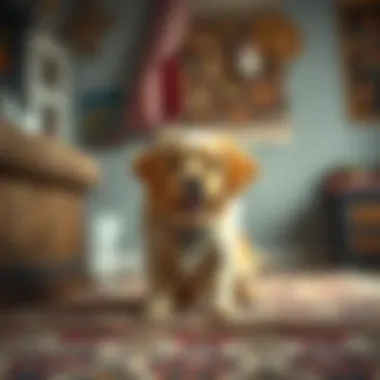
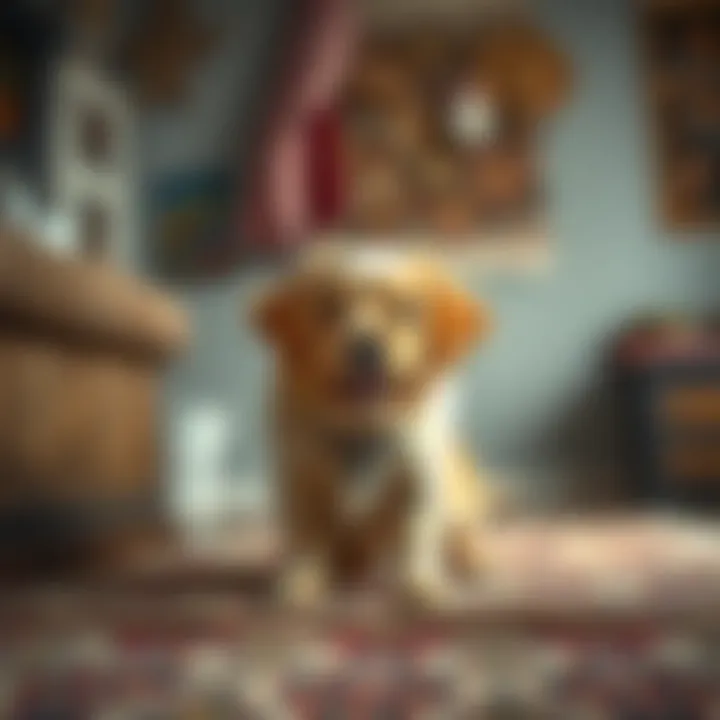
Synthetic Fiber Rugs
Synthetic fiber rugs, such as those made from nylon or polyester, offer another robust solution for managing muddy paws. They are manufactured to withstand heavy use while maintaining their shape and appearance over time. These rugs are resistant to stains, which is a blessing when your dog runs in from outside with muddy feet.
In addition to practicality, synthetic rugs often have vibrant colors and patterns that can elevate the style of your space. They are typically less expensive than natural fibers and provide ease of maintenance. Here are several advantages of synthetic fiber rugs:
- Stain Resistance: Many synthetic fibers come treated with stain-resistant coatings, making clean-up easier.
- Affordability: Generally more budget-friendly than natural options.
- Durability: They stand up well against wear and tear, making them ideal for homes with active pets.
If you’re looking for a rug that marries durability with aesthetic versatility, synthetic fiber rugs deserve a serious look.
Natural Fiber Options
In the world of rugs, natural fibers such as jute, sisal, or seagrass can provide a more organic feel to your home while still addressing the need for practicality. While they may not be as stain-proof or easy to clean as synthetic options, their unique textures and aesthetic appeal can enhance the ambiance of a room.
Natural fiber rugs usually come with their own set of characteristics:
- Breathable Material: They tend to allow airflow, reducing odor and moisture retention.
- Eco-Friendly: Sourced from renewable materials, making them a better choice for environmentally conscious consumers.
- Unique Characteristics: Each rug has its own patterns and textures, ensuring that your choice is one-of-a-kind.
However, it’s worth noting that natural fiber rugs may require a bit more effort to maintain. Regular vacuuming and occasional professional cleanings can help keep them looking their best. If you option for natural fibers, consider placement in areas with lower foot traffic or alongside mats that can catch mud before it has a chance to settle.
Practical Maintenance Strategies
When it comes to managing muddy dog paws, it's clear that choosing the right rug is only half the battle. After all, without a solid maintenance routine, even the best rug can quickly become a muddy mess. Practical maintenance strategies are crucial because they not only prolong the lifespan of your rug but also keep your living space fresh and welcoming. Integrating these strategies into your household routine helps maintain the rug's appearance while ensuring hygiene. Here, we’ll delve into the specifics of how to maintain your rug effectively to tackle the muddy trails left by your furry friend.
Regular Cleaning Routines
A regular cleaning routine is perhaps the bedrock of effective rug maintenance. Just like brushing your dog's coat, giving your rug a little love goes a long way. Establishing a consistent cleaning schedule—perhaps twice a week, depending on your dog's tendencies—keeps the dirt buildup at bay. A few key steps to consider include:
- Vacuuming: This should be your first line of defense. Make sure to use a vacuum cleaner that’s effective for your rug's material. For instance, if you’re using a synthetic fiber rug, a standard vacuum will do just fine. If you’ve opted for natural fibers, a vacuum with adjustable settings may be necessary to prevent any damage.
- Spot Cleaning: Accidents happen, and it’s best to address them swiftly. Keep a spot cleaner readily accessible, and use it immediately after your dog brings mud indoors. Blot the area with a clean cloth rather than rubbing, as rubbing might push the dirt in deeper.
- Deep Cleaning: Every now and then, investing in a professional deep clean or using a carpet cleaner can restore your rug's charm. Look for a cleaner that doesn’t leave any residue behind, which might attract more dirt later.
A well-established cleaning routine ensures you're not left wrestling with a mountain of mud or stains when they build up.
Stain Removal Techniques
Even with the most diligent cleaning, stains can sometimes linger, particularly those stubborn muddy patches. Knowing how to tackle these stains effectively can mean the difference between a fresh-looking rug and an eyesore on your floor. Here’s how to manage those troublesome stains:
- Use the Right Solution: Choose a stain remover that’s compatible with your rug’s material. If it's a synthetic fiber, a mild detergent mixed with water can work wonders. For natural fiber rugs, opt for a solution that’s gentle and safe—consider a mix of vinegar and water for an eco-friendly approach.
- Dab, Don't Rub: Just like the regular cleaning routine, dab the stain gently. Apply the solution to a cloth and blot the area. This will lift the stain without damaging the fabric.
- Rinse Thoroughly: Always follow up by rinsing your rug with fresh water to remove any cleaning solution, as leftover soap can attract dirt.
- Dry Properly: After cleaning, make sure to allow the rug to dry completely. A damp rag can lead to mold growth, which is another layer of trouble you won’t want to deal with. Place the rug in a well-ventilated area or use a fan.
Knowing some effective stain removal techniques can save your rug from becoming permanently marked by muddy paws.
Proper Storage During Off-Season
With all this talk of cleaning and maintaining, let’s not forget about the importance of proper storage. Some seasons will naturally bring less mud into your home than others. Here are some tips for storing your rug when it’s not in active use:
- Clean Before Storage: Always clean your rug thoroughly before tucking it away. Any residues can cause deterioration over time, so this step is non-negotiable.
- Roll, Don’t Fold: Rolling the rug instead of folding it can prevent creases and maintain its shape. Store it in a cool, dry place.
- Use a Rug Bag: If you can, invest in a storage bag designed for rugs. This protects them from dust, pests, and moisture.
- Avoid Direct Sunlight: If you’re storing your rug in a bright area, cover it with a sheet or place it away from windows. Direct sunlight can bleach and damage the colors in the rug.
Proper storage ensures that when you’re ready to bring your rug out again, it remains in as good a shape as when you put it away. By getting a grip on these practical maintenance strategies, you’re ensuring that your rug continues to serve as a stylish and functional centerpiece in your home for years to come.
Evaluating Sustainability in Rug Selection
Choosing a rug goes beyond mere aesthetics or function. In today's world, with the increasing emphasis on sustainability, selecting eco-friendly rugs has garnered significant attention. For dog owners facing the muddy paws conundrum, understanding the sustainability aspects can make a world of difference. Not only do these rugs contribute to a greener planet, but they also reflect an individual's values and commitment to responsible living. The selection of sustainable rugs becomes a key consideration as it intertwines with health, environmental impact, and even durability.
Eco-Friendly Material Choices
When it comes to eco-friendly rugs, the material is a pivotal point. There is a range of options that offer practical solutions without hurting the earth. For instance, rugs made from bamboo fibers provide an excellent balance between durability and environmental friendliness. Bamboo grows rapidly and requires minimal resources, making it an ideal candidate for sustainable living.
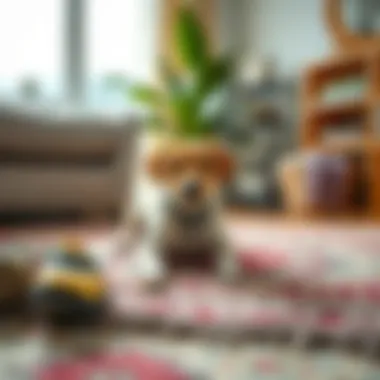
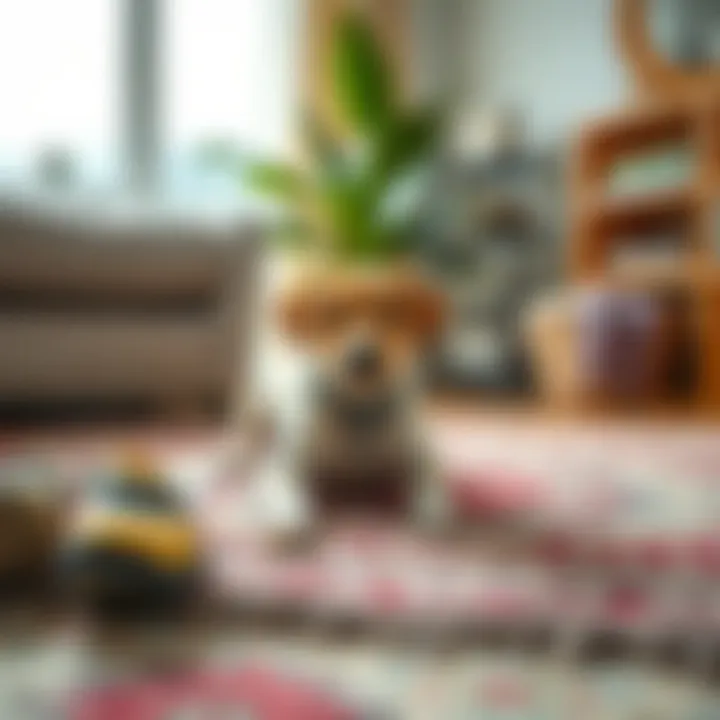
Another option is wool rugs, which are naturally renewable and biodegradable. Unlike synthetic materials, wool absorbs moisture and can resist dirt, hence making it a practical choice for managing muddy paws. An added benefit is that it possesses natural insulating properties, which keeps homes warmer during colder months.
Moreover, rugs crafted from recycled materials, such as plastic bottles, help reduce waste. They are incredibly versatile, not to mention their resilience against stains and spills. When evaluating your options, be sure to inquire about the sourcing of these materials and their lifecycle. Are they sourced ethically? What chemicals were used during production? Answering these questions can help in making a well-informed decision.
The Role of Certified Products
Certification plays a significant role in ensuring that the products we choose genuinely meet sustainability claims. Look for rugs that are certified by reputable organizations like the Global Organic Textile Standard (GOTS) or the Environmental Protection Agency (EPA). These certifications confirm that the rug is manufactured with strict environmental guidelines in mind.
Purchasing certified products means you are not only supporting eco-friendly practices but also investing in your home’s health. Rugs that are certified often contain fewer volatile organic compounds (VOCs), which can be harmful when inhaled over time. In homes with pets, this is especially crucial.
Furthermore, many consumers find peace of mind in knowing their purchases are helping to promote sustainable practices across industries. In the end, opting for certified rugs can affirm your responsibility toward a better future for our planet.
Choosing eco-friendly rugs is not just a trend, but a commitment to future generations. Every little choice counts.
Sustainability in rug selection isn't merely a matter of style—it's an essential component of our collective responsibility toward nature. Selecting sustainable materials and certified products can lead to a cleaner, greener living environment, making it an important avenue to explore for any conscientious dog owner.
Final Considerations Before Purchase
Before diving into the bustling world of rug shopping, it’s crucial to understand that selecting the right rug goes beyond mere aesthetics. For dog owners, especially those battling the muddy paw print conundrum, certain factors come into play that can significantly impact both functionality and satisfaction. When it comes to purchasing a rug, it’s essential to create a shortlist of considerations—those that take into account budget constraints, user experiences, and material quality. This stage acts as the final gatekeeper ensuring that you pick not just any rug, but one that genuinely complements your lifestyle.
Budget Assessment
Navigating the rug market without setting a clear budget is akin to sailing without a map. It can lead you not only to overspend but also to feeling disheartened by options that are out of reach. When assessing your budget, consider the following factors:
- Cost of materials: Handmade rugs or high-end synthetics often come with a heftier price tag. However, it's not merely about the sticker price; durability and longevity should factor into your assessment.
- Maintenance expenses: A cheaper rug may need frequent replacements or cleaning, adding up over time. Allocate for upkeep costs, as this might alter your choice significantly.
- Long-term value: It’s wise to view your investment holistically. A slightly more expensive rug that withstands wear and tear can be more economical in the long run.
As you chart your budget, avoid the temptation of impulse buys; those plush rugs might catch your eye, but is it worth the dent in your wallet?
Assessing User Reviews and Recommendations
User reviews often serve as the oracle in the realm of product purchases. They provide real-life insights that can’t be found in product descriptions or flashy ads. Here’s how to effectively sift through reviews:
- Focus on relevant feedback: Look for reviewers who mention pets, especially those with similar breeds. Their experiences will resonate more with your realities.
- Watch for patterns: If multiple users mention a particular flaw—be it durability or cleaning difficulties—it’s worth paying heed.
- Overall ratings vs. detailed accounts: A high rating might be appealing, but dig deeper into why that rating exists. An enjoyable aesthetic but poor functionality might not align with your needs.
"Real opinions from fellow dog owners can illuminate hidden truths that manufacturers might gloss over, revealing which rugs are merely pretty versus those that stand the test of muddy paws."
Sampling Material Before Commitment
Once you have a budget and a grasp on general feedback from users, testing before you buy can be invaluable. Here are key insights into the sampling process:
- Feel and texture: Running your fingers over a rug can reveal much about its comfort and suitability for your living space. Look for something that feels good underfoot yet durable enough to withstand your dog’s antics.
- Resilience testing: If possible, take samples home and have your dog interact with them. Watch how it holds up to their paws—some fibers may trap dirt, while others resist it like a champ.
- Check for odor: Some rugs, especially synthetic ones, can emit smells when new. Make sure any unpleasant scent dissipates quickly; you don’t want your lovely living room transformed into a pet’s corner of discomfort.
By taking these final considerations into account, you'll be better prepared to select a rug that not only looks great but also stands up to the demands of a dog-friendly household.
Culmination: Making an Informed Choice
In the intricate world of home decor, selecting the right rug to combat the relentlessness of muddy dog paws is more than just a stylistic choice; it’s a practical necessity. This article underscores the importance of making an informed decision. Knowing what options are available and understanding the specific needs of your household can lead to a choice that suits both your lifestyle and aesthetic preferences.
A well-chosen rug can protect your flooring from dirt and wear, while still complementing your interior design. The right materials, patterns, and cleaning strategies can enhance your living space and bring peace of mind when it comes to managing muddy footprints.
Recapitulating Key Insights
- Material Matters: The durability and cleanability of rug materials should never be underestimated. Rugs made from synthetic fibers, for instance, often offer high resistance to mud, water, and stains, thereby simplifying maintenance.
- Design and Style: Rugs are not merely functional; they also play a significant role in your home’s decor. Selecting a color and pattern that aligns with your home’s overall aesthetic can seamlessly blend practicality with style.
- Maintenance Strategies: Regular upkeep will extend the life of your rug. Developing a cleaning routine can make a world of difference in keeping mud at bay. Knowing how to treat stains effectively can also spare you from further headaches down the line.
- Sustainability Concerns: In today’s world, choosing eco-friendly options is becoming increasingly paramount. Selecting rugs made from sustainable materials not only supports the environment, but it can also be beneficial in creating a healthier indoor atmosphere.
These insights form the backbone of a well-rounded selection process for your rug, aligning your needs with available options to confront the muddy reality of pet ownership.
Encouraging Thoughtful Selection
As you prepare to make that important purchase decision, consider the factors discussed throughout this article. It's vital to reflect on how a rug can alleviate the challenges posed by muddy paws, while also fitting into the broader context of your home’s design framework.
Do not be in haste. Perhaps, take a moment to scower user reviews, tastefully seek samples before you purchase, and firmly assess your budget parameters.
Dog ownership is a journey, and the rug you choose can forge a path that is not just about functionality, but one that brings warmth, style, and comfort into your living space. By choosing wisely, you support not only the practicality but also the aesthetic of your home, fostering a space that's as enduring as it is beautiful.















